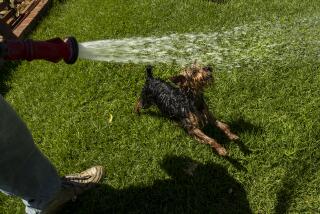Amid Drought, Taps Kept Open in Florida
- Share via
MIAMI BEACH, Fla. — One of the first things Kevin Gourrier did when he returned from a business trip last month was water his lawn.
The 36-year-old stockbroker didn’t think twice about running a garden hose over his parched grass. But he was violating strict new regulations aimed at easing Florida’s worst water shortage in a decade.
“I didn’t even know there was a water restriction,” Gourrier said. “I just got back into town, and my grass is about dead.”
Earlier in January, Miami Beach officials designated two days a week when residents can water their lawns or wash their cars. Thirty-three other counties in south and central Florida have also imposed restrictions on homeowners, farmers, golf courses and other water-using industries.
Lack of rainfall, a three-year drought and low water levels in Lake Okeechobee and Tampa Bay-area rivers have contributed to a widespread water crunch. Average rainfall in south and central Florida is about 15 inches below the normal total of 50 to 60 inches.
The restrictions are the toughest since a 1991 drought. Residents, after a written warning, can be fined up to $500.
But some experts say it may be difficult to reduce water usage in a state known for its lush landscape and the Everglades.
“They open the tap and the water still comes out,” said Florida International University professor Ron Jones, a regional water expert. “They assume this is a bunch of crazy people panicking. Everyone knows Florida is just one big swamp. They think it’s wet all year ‘round, and it’s not.”
Residents from West Palm Beach to Key West have reduced water usage by only 12% since tighter restrictions went into effect Jan. 17--far short of the 30% goal set by the South Florida Water Management District.
“People aren’t cutting back as much as they should,” said Adriana Lamar, Miami-Dade’s water spokeswoman. “They hear about it today and they see rain and they forget about it.”
In South Florida especially, conservation isn’t a top priority. Residents are still dealing with flood damage from an October storm that dropped nearly 20 inches of rain over two days and prompted President Clinton to declare much of the region a disaster area.
“I had water inside the house. It was 1 inch [high] inside,” said Carlos Morales, 70. “My furniture’s gone. Where’d the water go?”
The deluge drained out to sea while less than an inch of rain fell on Lake Okeechobee, the primary source of water for growers and surrounding towns.
But some people are blaming the South Florida Water Management District for causing its own water woes.
Water managers drained 2 feet of water from Lake Okeechobee last spring, in part because high water was killing fish-nurturing marshes. But the hurricane season was drier than expected, and the level is now below 11 feet and falling.
Bob Doran, a Tampa activist, said the city and developers need to encourage long-term solutions, such as planting indigenous landscapes that don’t require watering.
“I’ve xeriscaped my entire property,” he said. “I’m hoping more people will consider doing that.”
*
South Florida Water Management District: https://www.sfwmd.gov/
*
Southwest Florida Water Management District: https://www.swfwmd.state.fl.us/
More to Read
Sign up for Essential California
The most important California stories and recommendations in your inbox every morning.
You may occasionally receive promotional content from the Los Angeles Times.













